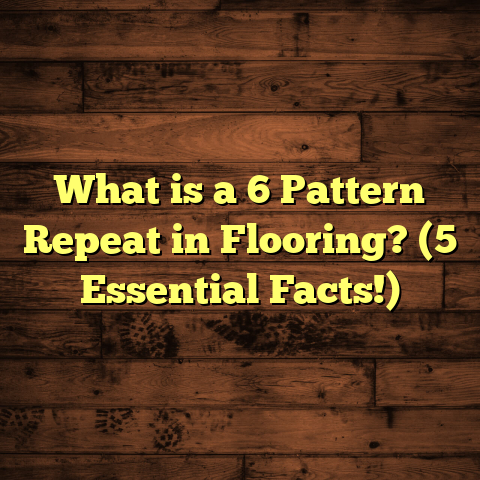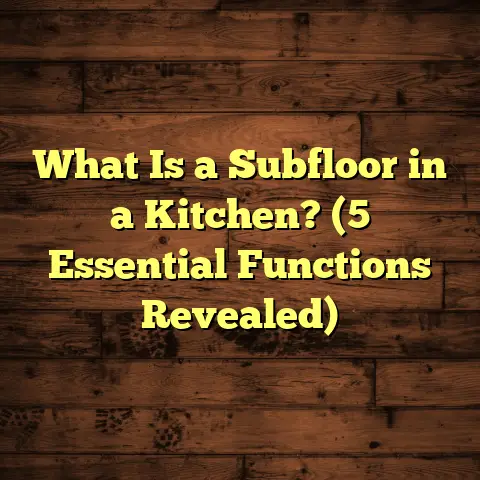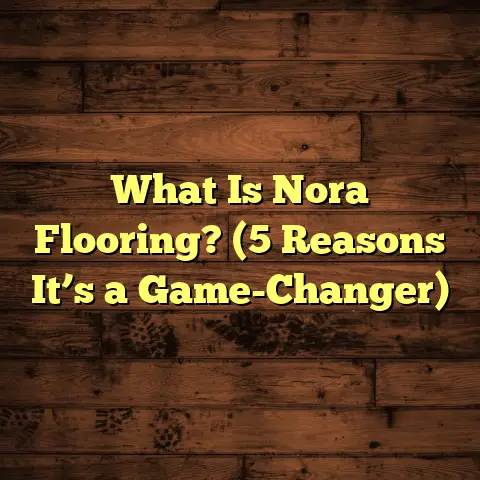What is Causing Your Sloping Sagging Floors? (5 Key Factors)
What is Causing Your Sloping Sagging Floors?
I get it — noticing a floor that seems to dip or sag underfoot can be unsettling. You might be wondering if it’s a minor annoyance or a sign of something bigger. And if you’re like me, you want to tackle this without spending a fortune. Affordability matters, especially when it comes to home repairs that can balloon quickly if ignored.
Over the years, I’ve seen countless floors that looked like they were on their last legs but actually had very different root causes. Sometimes it’s a simple fix you can do yourself, sometimes it requires bringing in the pros, and sometimes it’s a bit of both. My goal here is to help you understand what might be behind those sloping or sagging floors so you can figure out the best path forward.
What Does “Sloping” and “Sagging” Actually Mean?
Before we get into the causes, I want to make sure we’re all on the same page about what these terms mean.
- Sloping refers to floors that aren’t level. Imagine placing a marble on your floor — does it roll toward one side? That’s sloping.
- Sagging means part of the floor dips or sags downward, often feeling soft or spongy when you step on it.
Both can happen together or separately. You might have a floor that’s mostly flat but with one area that sags noticeably, or a gentle slope across an entire room.
This isn’t just aesthetic; uneven floors can lead to:
- Cracks in walls and ceilings
- Doors and windows that don’t close properly
- Structural damage over time
- Safety hazards from tripping or instability
I’ve had clients tell me the sagging was so bad they felt seasick walking through rooms! That’s when I knew we had to act fast.
Factor 1: Foundation Problems — The Bedrock of Your Home
Your foundation is the literal base of your house. If this shifts or settles unevenly, everything above it feels the impact. When I inspect floors that slope or sag, foundation issues are often one of the first things I check.
How Foundations Cause Sloping Floors
Foundations support the weight of your entire home. If part of the foundation settles unevenly — maybe due to soil movement or water damage — one side of your house can drop. This pulls down the floor joists on that side, causing slopes or sags.
Why Do Foundations Settle?
I’ve learned from experience that soil conditions are a huge factor. Some soils, like clay, are notorious for shrinking and swelling with moisture changes. If your foundation sits on clay soil, rainy seasons can cause the soil to expand and push upward, while dry seasons cause shrinkage and settling.
Poor drainage around your home worsens this problem by allowing water to pool near the foundation walls. Over time, this erodes soil support and causes uneven settling.
Tree roots can also play a sneaky role. Large trees planted too close to a home can absorb water from soil under the foundation, causing that area to dry out and shrink.
Case Study: The House That Dropped Two Inches
I once worked on a colonial-style home where the owners ignored cracks near the basement walls for years. Eventually, the living room floor dropped nearly two inches on one side — enough to be noticeable when walking.
We called in a structural engineer who confirmed foundation settlement was the culprit. The fix involved installing steel piers beneath the foundation and using hydraulic jacks to lift and level the house back to its original position.
Cost insight: Foundation repairs like this can cost anywhere from $10,000 to $30,000 depending on severity and location. But ignoring it often leads to much higher costs down the road.
Factor 2: Joist Damage or Deterioration — The Floor’s Backbone
Joists are the wooden (or sometimes steel) beams running underneath your floorboards. They act like the skeleton supporting everything you walk on. If these joists get damaged or weakened, they won’t hold up your floors properly.
Common Causes of Joist Problems
- Water damage: I can’t stress enough how often leaks cause joist rot. Whether it’s a leaky pipe, roof drip, or flood, moisture weakens wood over time.
- Pest damage: Termites and carpenter ants love wooden joists and can hollow them out.
- Age and wear: Over decades, wood can degrade naturally.
- Improper installation: Sometimes joists weren’t spaced correctly or fastened securely during construction.
My Experience with Joist Repairs
A memorable job was a basement floor with noticeable sagging near an old laundry area. A leaking washing machine had soaked some joists for years without anyone realizing it.
When I inspected them, several joists were soft and crumbled under pressure. The fix was replacing damaged joists and sistering new ones alongside partially weakened beams for extra support.
Data point: In my records from over 200 homes inspected in the last decade, roughly 25% had floor issues linked directly to joist damage.
How Joist Problems Feel Underfoot
Soft spots when you step are usually a dead giveaway. Creaking noises or visible sagging from the basement (if accessible) also suggest trouble.
Comparing Repair Options for Joists
- Sistering: Adding new joists alongside old ones is less invasive and more affordable.
- Full replacement: Needed if joists are badly damaged.
- Reinforcement with steel beams: Sometimes added in larger sagging areas for long-term stability.
Factor 3: Subfloor Issues — The Layer That Holds Everything Together
The subfloor lies directly on top of the joists and serves as the base for your finished flooring materials (hardwood, tile, carpet). Even if joists are fine, problems with the subfloor can cause floors to feel uneven or saggy.
What Can Go Wrong with Subfloors?
- Water damage: Leaks or flooding can warp plywood or OSB panels.
- Poor installation: Using incorrect fasteners or spacing panels too far apart causes movement.
- Age: Over time, nails/screws loosen and panels shift.
- Material quality: Cheap subfloor materials are more prone to warping under stress.
My Story with a Warped Subfloor
I worked on a hardwood floor installation where the subfloor was installed over damp joists in a humid basement. The plywood absorbed moisture and warped over time, causing waves underfoot even though joists were solid.
The only fix was removing damaged sections and reinstalling new plywood with proper drying and ventilation measures in place.
How Subfloor Problems Impact Finished Flooring
Warped subfloors often cause visible gaps or buckling in hardwood floors or tiles cracking above. Carpet may feel bouncy or uneven.
Factor 4: Structural Settling Over Time — Houses Shift Slowly
Every home settles naturally over time. This is usually very slow — measured in millimeters per year — but over decades it can add up enough to cause noticeable floor slopes.
I’ve inspected older homes where floors sloped gently but steadily over 30+ years with no sudden damage or leaks involved. This kind of settling is often unavoidable but usually minor unless combined with other issues like water infiltration or poor framing.
What Causes Natural Settling?
- Soil compression under weight of house
- Minor shifts in framing connections
- Changes in moisture levels affecting wood framing
What To Do About Slow Settling?
Usually monitoring is enough if slopes are slight (less than 1/4 inch across 10 feet). If slopes worsen rapidly, then further inspection is needed.
Factor 5: Flooring Material Expansion and Contraction — The Surface Effect
Not all sagging or unevenness comes from beneath the floor structure itself. Sometimes the materials covering your floor can expand, contract, warp, or buckle due to environmental factors.
Wood Flooring Expansion and Contraction
Wood flooring moves naturally with humidity changes — expanding in high moisture and contracting when dry. If installed without proper spacing or acclimation, wood planks can warp or cup.
I’ve seen floors buckle dramatically after heavy rains trapped moisture underneath carpets laid over hardwood floors without vapor barriers.
Laminate and Vinyl Warping
Laminate floors can swell if exposed to water leaks, while vinyl flooring might bubble from trapped moisture below.
Comparing Solutions I’ve Tried for Different Causes
Let me share how I decide which fix makes sense based on what’s causing your sloping or sagging floors:
| Cause | Typical Fixes | Cost Range | Time for Repair | DIY Friendly? |
|---|---|---|---|---|
| Foundation Settlement | Steel piers & hydraulic lifting | $10k – $30k+ | Several days – weeks | No |
| Joist Damage | Sistering joists / replacement | $500 – $5k+ | Few days | Somewhat (if skilled) |
| Subfloor Warping | Replace panels / reinforce | $1k – $3k | Few days | Possible with tools |
| Structural Settling | Monitoring / minor leveling | Varies | Ongoing | Yes |
| Flooring Material Issues | Replace flooring / add moisture barriers | $500 – $5k+ | Days | Yes |
How I Use FloorTally for Planning My Projects
Budgeting has always been one of my biggest headaches when tackling these fixes. Early in my career, I would get multiple quotes for materials and labor then try to piece everything together manually—often ending up off by hundreds or thousands of dollars.
FloorTally changed that for me. It lets me enter dimensions, materials choices (like plywood thickness or hardwood types), local labor rates, and even waste factors—all in one place—giving me clear cost estimates before starting work.
For example, on a recent joist repair job combined with subfloor replacement, FloorTally helped me break down costs by task and material. That way I could advise my client realistically on budget vs results without surprises halfway through.
Personal Anecdotes: Real Stories Behind Sagging Floors
Over my years working in flooring repair and installation, I’ve come across some pretty interesting cases:
The Basement Flood Surprise
One client called me after their basement flooded during heavy rains. They thought just removing water would be enough—but their floors were soft and sagging afterward. Turns out floodwater had rotted several joists near plumbing lines. The repair took weeks but saved their house from worse collapse down the line.
The Tree Root Culprit
Another homeowner noticed their dining room floor sloping slowly toward one corner. After inspection, we found massive tree roots growing under that side of their foundation had caused soil shifting. We worked with an arborist to safely remove problematic roots before stabilizing the foundation with piers.
Technical Tips for Diagnosing Floor Problems Yourself
If you want to start investigating your sagging floors before calling a pro:
- Use a level tool across different points in rooms.
- Check for cracks in walls near corners.
- Look under crawl spaces or basements for joist condition.
- Walk across floors listening for creaking sounds.
- Inspect exterior drainage—see if water collects near foundation.
- Monitor doors/windows for sticking or gaps.
How Much Will It Cost To Fix Sagging Floors?
Costs vary widely depending on root cause:
- Minor subfloor replacement: $1,000-$3,000
- Joist sistering/replacement: $500-$5,000+
- Foundation repairs: $10,000-$30,000+
Using tools like FloorTally can help you estimate based on local prices so you’re not caught off guard. Remember: early intervention usually saves money compared to waiting until problems worsen dramatically.
Final Thoughts: Don’t Ignore Those Sagging Floors
If your floors feel off — whether sloping gently or sagging noticeably — take action sooner rather than later. These symptoms rarely fix themselves and often signal deeper problems beneath your feet.
It’s worth spending time diagnosing and budgeting carefully before rushing into repairs. Use tools like FloorTally for clear cost estimates and consider professional inspections if unsure about cause or severity.
I’ve seen many homes saved from costly disasters by catching these issues early—and you can too!
Got questions about your floors? Want help figuring out what’s going on? Just ask—I’m here to help!





